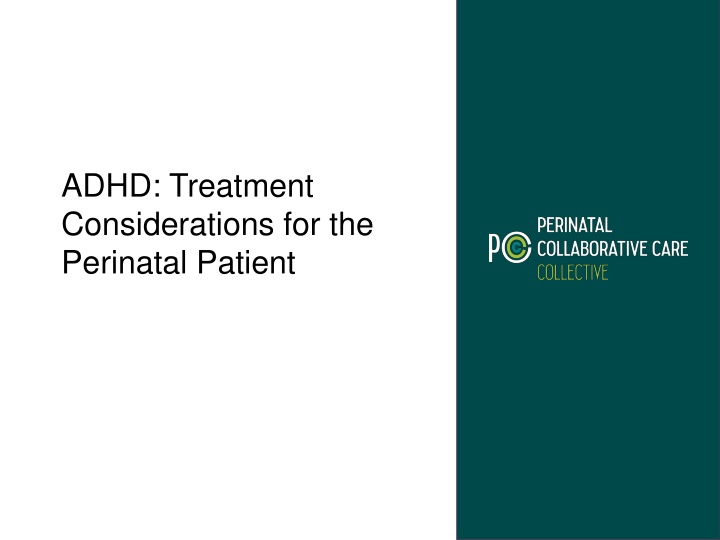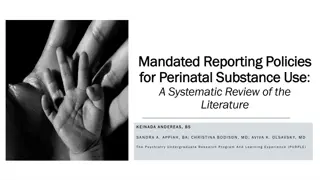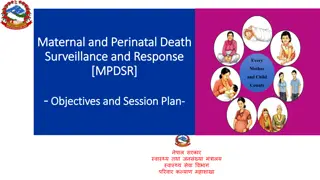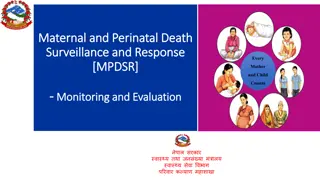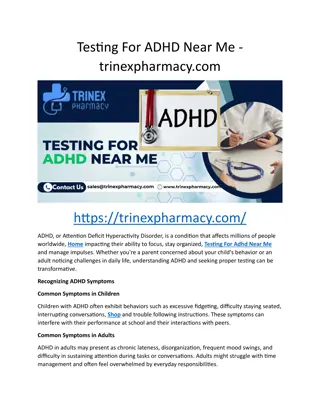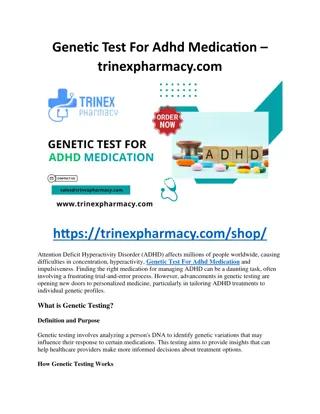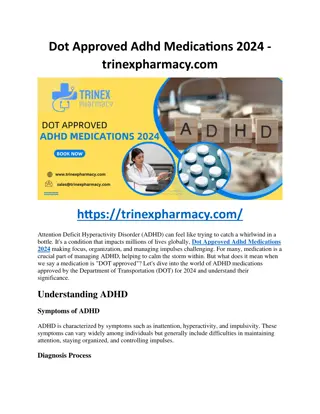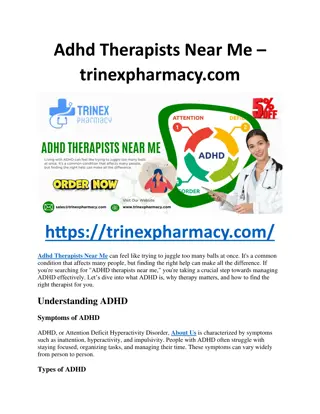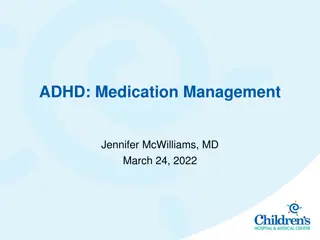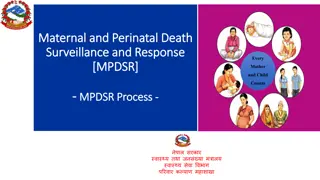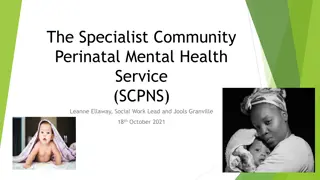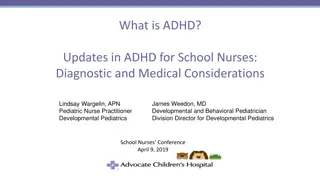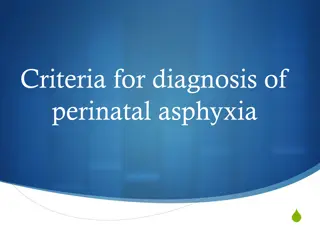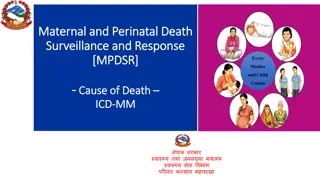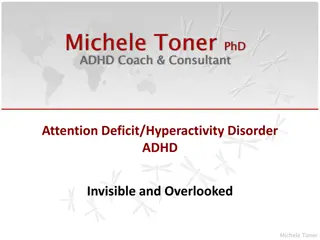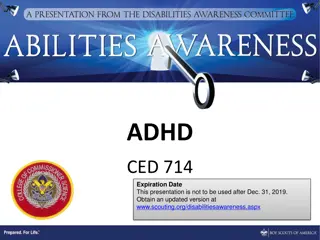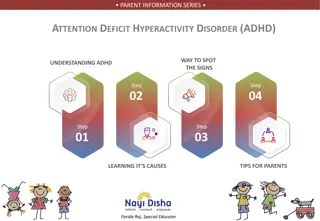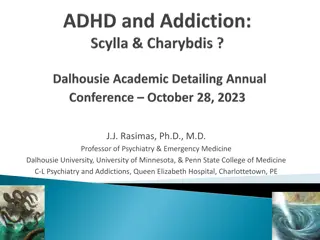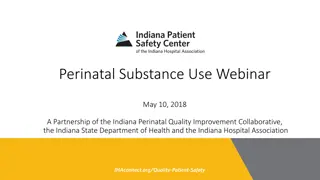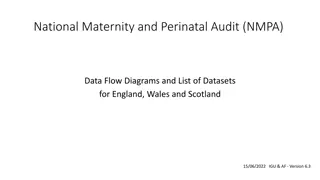ADHD Treatment Considerations for Perinatal Patients
ADHD, a neurodevelopmental disorder, can manifest as inattention and hyperactivity-impulsivity. This presentation covers diagnostic criteria, types of ADHD, DSM-5 criteria, and treatment considerations for perinatal patients. Understanding the clinical aspects and management of ADHD in pregnant and lactating individuals is crucial for appropriate care.
Download Presentation

Please find below an Image/Link to download the presentation.
The content on the website is provided AS IS for your information and personal use only. It may not be sold, licensed, or shared on other websites without obtaining consent from the author.If you encounter any issues during the download, it is possible that the publisher has removed the file from their server.
You are allowed to download the files provided on this website for personal or commercial use, subject to the condition that they are used lawfully. All files are the property of their respective owners.
The content on the website is provided AS IS for your information and personal use only. It may not be sold, licensed, or shared on other websites without obtaining consent from the author.
E N D
Presentation Transcript
ADHD: Treatment Considerations for the Perinatal Patient
Objectives: Review the diagnostic criteria for ADHD and how to identify ADHD in adults Review basic neurobiology of ADHD Discuss the management of ADHD in general Discuss treatment considerations in pregnancy/lactation 2025; Additional credits
What is ADHD? A neurodevelopmental disorder consisting of a persistent pattern of inattention and/or hyperactivity-impulsivity that interferes with functioning or development Expected to emerge early in life 3 Types: ADHD Predominantly Inattentive type ADHD Predominantly Hyperactive-Impulsive type ADHD Combined type
DSM-5 Criteria for ADHD Predominantly Inattentive Type Fails to give close attention to details or makes careless mistakes Has trouble sustaining attention Does not appear to listen Struggles to follow through with instructions Has trouble organizing tasks and activities Avoids, dislikes, or is reluctant to do tasks that require mental effort Frequently loses things Is easily distracted Is forgetful in daily activities 2025; Additional credits
DSM-5 Criteria for ADHD Predominantly Hyperactive- Impulsive Type Fidgets with hands or feet or squirms in seat Has difficulty remaining seated Runs about or climbs excessively (in adults extreme restlessness) Difficulty engaging in activities quietly Is on the go , as if driven by a motor Talks excessively Blurts out answers before questions have been completed or completes others sentences Has trouble waiting or taking turns Interrupts or intrudes upon others 2025; Additional credits
DSM-5 Criteria for ADHD For all 3 types, must have: 6 symptoms in the respective category in children; 5 symptoms in adults Symptoms 6 months duration Symptoms must be or have been present before 12 years of age Symptoms must be present in 2 or more settings (home, work, relationships) Symptoms interfere with social, school, or work functioning Symptoms are not better explained by another mental disorder (mood, anxiety, personality disorders) 2025; Additional credits
Reasons for Missed ADHD Diagnosis in Childhood Barriers to health care access as children: Socioeconomic barriers Cultural barriers The predominantly inattentive type may have been missed in childhood especially in intelligent individuals who found ways to compensate ADHD symptoms may not manifest until stressors at critical points in life exceed the person s capacity to compensate transition to college, demanding profession, parenthood, loss of partner/spouse Adults may present after their children have been diagnosed with ADHD, and they realize they had the same issues as children 2025; Additional credits
Presentation in Clinical Settings Complaints of struggles attending to work, children, home duties, school Complaints of poor concentration, organization, time management Report conflict with partners/families Difficulty controlling their tempers Feel overstimulated, overwhelmed Complaints of anxiety, panic 2025; Additional credits
Impact of Untreated ADHD Poor self-esteem Conflicts in relationships Academic struggles despite adequate intellectual abilities Occupational difficulties Obesity MVA s Drug use/addictive behaviors Antisocial behaviors Higher use of services (medical, judicial, financial assistance) 2025; Additional credits
Etiology of ADHD Strong Genetic Component https://tnnfb.com/understanding-adhd-types-symptoms-causes-and-cures/ Many genes are implicated with most of them related to dopamine signaling 2025; Additional credits
Genetics + Environment Strong genetic component, but not all individuals with the genetic predisposition will go on to have ADHD ADHD occurs via the interaction between genes and the environment 2025; Additional credits
Environmental Risk Factors in Prenatal Period Prenatal maternal illnesses: Gestational DM, pre-eclampsia Prenatal tobacco, alcohol, and or other drug exposure Hypoxia (placental abruptions, birth trauma) Prematurity/low birth weight Perinatal infections Lead exposure Nutritional deficiencies: Iron, vitamin D 2025; Additional credits
Other Environmental Risk Factors Diet: processed foods, preservatives, low omega 3 fatty acids, allergens Substance use: can lead to neuronal loss and decreased brain volume Sleep disorders Effects of technology: Excessive screen time is associated with cognitive deficits, behavioral problems, and changes in brain structure 2025; Additional credits
Neurobiology of ADHD Key Neurotransmitters: Norepinephrine NE Dopamine DA ADHD is a disorder of abnormal DA and NE firing Proper functioning is achieved by low to modest levels of both DA and NE Too little or too much can lead to abnormal firing 2025; Additional credits
Screening for ADHD 1) Detailed clinical interview: evaluate current symptoms AND whether they are causing impairments across multiple domains Rule out other conditions screen for depression/anxiety and other medical conditions *But, the presence of other conditions does not automatically rule out ADHD Ask about their experience in school (IEP or other accommodations, completion of school, behavioral issues in school?) Use screening tools (next slide) 2) 3) 4) 2025; Additional credits
ADHD Self-Report Scale (ASRS-V1.1) Advantages: Quick self-report screen Can help rule out: 98% negative predictive value Disadvantages: Susceptible to overreporting/faking Not diagnostic! 4 out of 6 in the shaded area = positive screen 2025; Additional credits
Treatment Options: Non-pharmacological options First line treatment of adult ADHD is medication; however, medication alone may not provide sufficient improvement or may not be tolerated A systematic review1 in 2020, including 53 studies, found a significant positive effect on outcomes associated with ADHD in 92% of the studies Strongest with Cognitive Behavioral Therapy (CBT) Mindfulness Dialectical Behavioral Therapy Neurofeedback ADHD Coaching Exercise 2025; Additional credits
Treatment Options: Non-Stimulant Medications NE reuptake inhibitors DA and NE reuptake inhibitor Strattera/Atomoxetine Qelbree/Viloxazine Wellbutrin/Bupropion DA reuptake inhibitor Alpha agonists release NE Tenex/IR guanfacine Intuniv/ER guanfacine Catapress/IR clonidine Kapvay/ER clonidine Provigil/Modafinil
Pregnancy Data with Non-Stimulants Limited, but we have the most data with atomoxetine and bupropion Atomoxetine: In study by Broms et al, it was not associated with major congenital malformations In study by Huybrechts et al, it was not associated with PEC, placental abruption, PTB, IUGR/SGA Bupropion: Overall, data are reassuring as they do NOT demonstrate an increased risk of congenital malformations. The ones that do, show an absolute risk of a congenital heart defect at 2.1/1000 births vs a prevalence of 0.8/1000 births in the general population Broms G, Hernandez-Diaz S, Huybrechts KF, et al. J Clin Psychiatry 2023; 84(1):22m14430; Huybrechts KF, Broms G, Christensen LB, et al. JAMA Psychiatry 2018; 75(2):167-175; Alwan et al Am J Obstet Gynecol 2010;203:52.e1-6; Reller et al J Pediatr 2008;153:807-813. 2025; Additional credits
Treatment Options: Stimulant Medications Amphetamine Adderall class: Amphetamine/dexamphetamine Immediate release (IR) Extended release (ER/XR) Amphetamine IR and ER/XR ODT Dextroamphetamine IR and ER/XR Lisdexamphetamine dimesylate Methylphenidate Ritalin class: Methylphenidate Immediate release (IR) Extended release (ER/XR) Chewable Oral solution ODT Patch Dexmethylphenidate IR and ER/XR 2025; Additional credits
Pregnancy Data with Stimulants A Cohort Study from the International Pregnancy Safety Study Consortium Huybrechts, et.al.; JAMA Psychiatry 2017 1,813,894 pregnancies in the US were evaluated for stimulant use in the first trimester (Medicare registry covering close to 50% of US pregnancies) Including Nordic data (Denmark, Finland, Iceland, Norway, Sweden), where methylphenidate is used, they looked at a total of 2,560,069 births Results: small increase in the risk of cardiac malformations associated with intrauterine exposure to methylphenidate but not to amphetamine Cardiac malformations affect ~ 10 infants per 1000 births With methylphenidate, there was an increase corresponding to 3 additional infants: 13 per 1000 births 2025; Additional credits
Pregnancy Data with Stimulants Placental Complications Associated with Psychostimulant Use in Pregnancy Cohen, et al, Obstetric Gynecology 2017 Population-based cohort study of pregnant women enrolled in Medicaid from 2000 to 2010 Looked at risks of adverse placental-associated pregnancy outcomes (pre-eclampsia or PEC, placental abruption, growth restriction, and preterm birth or PTB) Women who received stimulants in the first half of pregnancy vs the entire pregnancy vs unexposed women Atomoxetine-treated women served as the negative controls Pregnancies exposed to: Amphetamine-Dextroamphetamine: n=3331 Methylphenidate: n=1515 No medications: n=1,461,493 Results: Atomoxetine was not associated with the outcomes studied Stimulant use was associated with a small increased RR of PEC and PTB But, absolute risks are small; therefore, women with significant ADHD should NOT be counseled to suspend their ADHD treatment based on these findings 2025; Additional credits
Risk of Neurodevelopmental Disorders? Prescription stimulant use during pregnancy and risk of neurodevelopmental disorders in children. Suarez EA et al. JAMA Psychiatry. 2024 Cohort study that looked at association between in utero exposure to stimulant use and neurodevelopmental disorders (ASD, ADHD, learning disorders, developmental speech/language disorder, intellectual disability, behavioral disorder) Over 4 million pregnant individuals ages 12 to 55 years who filled prescriptions for stimulants from 3 months prior to pregnancy through 1 month after delivery Looked at stimulant use in early pregnancy vs late pregnancy Follow up of up to 18 years Amphetamine/dextroamphetamine: Early exposure in pregnancy: 21,573 women Late exposure in pregnancy: 7065 Methylphenidate: Early exposure in pregnancy: 4377 Late exposure in pregnancy: 1123 Results: Neither stimulant class was associated with NDD s 2025; Additional credits
Lactation Data with Non-Stimulants Medication Relative Infant Dose (RID) Pediatric Concerns Monitor Infants For: Atomoxetine No data available No data Irritability, poor sleep, tremors, weight gain Clonidine 0.9-7.1%, could potentially reduce prolactin secretion None reported Drowsiness, poor feeding, constipation, weight gain Guanfacine No data available but caution advised given low molecular weight (BBB entry) None reported Sedation, weakness, hypotension Bupropion 0.11-1.99% 2 cases of seizures have been reported but a febrile seizure could not be ruled out for 1 of them Sedation or irritability, seizures, poor feeding, poor weight gain The benefits of treating moderate-severe ADHD with clonidine, guanfacine, and bupropion outweigh the potential risks in lactation, but close monitoring is warranted 2025; Additional credits
Lactation Data with Stimulants Medication Relative Infant Dose (RID) Pediatric Concerns Monitor Infants For: Amph/Dexamph IR/XR, Dexamph (other formulations) 2.46-7.25% None reported Agitation, insomnia, decreased appetite, tremor MTP (and different formulations) 0.19-0.4% None reported Agitation, insomnia, decreased appetite, tremor Lisdexamph (Vyvanse) 1.8-6.2% None reported Agitation, insomnia, decreased appetite, tremor The benefits of treating moderate-severe ADHD with stimulants outweigh the potential risks in lactation but close monitoring is warranted 2025; Additional credits
